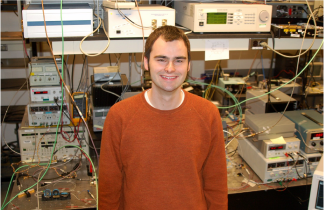
(Above: Video Interviews with Program Chairs: from CLEO website)
If you haven't been to the CLEO 2011 conference website in the last week (or even if you have), it is worth taking a look at the video interviews with the programming chairs. There are 11 videos addressing the chairs' top picks for talks, their views of trends in optics, advice for conference goers, and their impressions of CLEO's scope and impact for optics research.
In the interviews, the chairs spoke in unison of how CLEO is unique among optics conferences in its breadth of research, particularly spanning basic research to market-ready products. On one hand, you can find talks on fundamental quantum mechanics such as those in the Symposium on the Zeno Effect in Optoelectronics and Quantum Optics whose subject delves into the fundamental nature of measurement. The quantum Zeno effect (or paradox) refers to inhibiting quantum transitions by frequent, repeated measurement. For example, observing an unstable particle in an undecayed state collapses the wavefunction to this state. By quickly measuring it again and again, you can force the wavefunction to repeatedly collapse to the undecayed state by never giving it time to evolve. It never decays, analogous to how Zeno's arrow never hits its mark. So, how could this be used for quantum optics? Besides generically controlling quantum coherence or decoherence of a system, the quantum Zeno effect has applications in optical switching.
On the other hand, in session "Laser Micro and Nano Structuring", in CLEO: Technology and Applications: Industrial, Guido Hennig from Daetwyler Graphics AG, will give an invited talk, AMD4, "Laser Microstructuring and Processing in Printing Industry," discussing the use of high-power fiber lasers for engraving printing plates, as well as high-speed laser modulation for laser-induced ink transfer. In one of the video interviews, Harold Metcalf, from SUNY Stoneybrook, CLEO:QELS Fundamental Science General Co-Chair, aptly characterizes the wide scope of such interesting topics. "Looking over the program and the titles of the sessions, I feel like a kid in a candy store- with unlimited funds, but limited time. It's impossible to do everything," quips Metcalf. To view the "candy store" selection, which I highly recommend as a way of searching for interesting talks you might otherwise miss, go to the conference itinerary planner and click on "Search" and then the "Session Title" drop down menu. You'll be overwhelmed, impressed, and excited.
Some of the specific goodies highlighted by the program chairs in the video-interviews were contributed papers and invited talks discussing UV LEDs, photovoltaics, nanoscale laser sources, metamaterials, broadband spectroscopy, and integrating optics on-chip. Christian Wetzel of Rensselaer Polytechnic Institute, CLEO: Applications and Technology: Industrial Subcommittee Member, points to tutorial ATuD1, "Water and Air Treatment Using Ultraviolet Light Sources," by Gord Knight of Trojan Technologies, as well as invited talk AMC4, "New Concepts and Materials for Solar Power Conversion Devices," by Wladeck Walukiewicz, of University of California, Berkeley, both of which use group III nitride materials in unique ways to develop "green" photonics (Walukiewicz will discuss inserting another band gap within a band gap to increase solar cell efficiency). Seth Bank of University of Texas at Austin, CLEO: Science and Innovations 3: Semiconductor Lasers Alternate Chair, discusses how this year marks the "emergence of the the nanolaser" and recommends tutorial talk CTuG1, "Nanoscale Lasers: How Small Can they Go?" from Shun Lien Chuang of University of Illinois, Urbana-Champaign as well as device results from invited paper CTuG2, "Room Temperature CW Operation of Metal-Semiconductor Plasmonic Nanolasers with Subwavelength Cavity." Tim Carrig of Lockheed Martin, CLEO: Science and Innovations General Co-Chair, and CLEO: Applications and Technology General Chair, projects now will be the time that companies need to look at the fundamental research on optical metamaterials to begin understanding how to make market-ready products in the near-future. For introductory information on metamaterial applications, a good place to start will be tutorial QTuM1, "Optical Metatronics" from Nader Engheta from University of Pennsylvania.
The suggestions of talks and lists of recommendations from the chairs goes on. To find out more, click on the program chair video link on the CLEO main page.

No comments:
Post a Comment